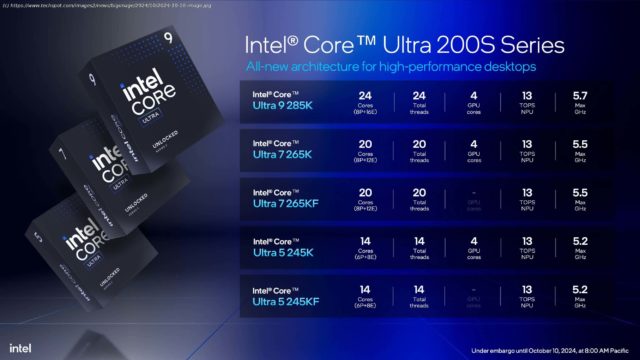The Core Ultra 200 series is an architectural overhaul compared to Raptor Lake, used on the 13th and 14th gen Core series. The P-cores have been upgraded.
Highly anticipated: Intel has announced the Core Ultra 200 CPU series for desktop PCs, also known as Arrow Lake, which introduces a brand new architecture. In Intel’s words, this will set them up for the future of desktop processors. However, we have mixed feelings about what Intel has shown so far. While there are some improvements over the 14th-gen, it’s questionable how competitive it will be – so let’s dive into what Intel has revealed.
The Core Ultra 200 series is an architectural overhaul compared to Raptor Lake, used on the 13th and 14th gen Core series. The P-cores have been upgraded to the new Lion Cove architecture, which Intel claims is „the fastest performance core for desktop PCs.“ The E-cores have also been upgraded to the Skymont architecture, bringing the desktop design in line with Intel’s recently announced Lunar Lake lineup for laptops.
Intel is claiming that the Lion Cove P-cores provide a 9% IPC uplift compared to Raptor Cove used in the 14th-gen. There are some interesting changes, such as the removal of hyperthreading, so now 8 P-cores come with 8 threads, instead of 16 like in previous generations. Other improvements include finer clock intervals, a wider core design, and an increase in L2 cache from 2MB to 3MB per core.
The changes to the E-cores are even more substantial, with Intel claiming a 32% IPC increase over Gracemont, the architecture used in Raptor Lake E-cores. These changes include a wider design, double the L2 cache bandwidth, and double the vector throughput. The 4MB of L2 cache is still used for each E-core cluster, with each cluster remaining at four cores.
The overall design still includes 36MB of L3 cache, accessible to both P and E-cores, contained within the compute tile. This is now a multi-tile design, instead of the monolithic approach seen with Raptor Lake, marking the first time Intel has brought this mobile design approach to desktop. However, the layout differs from the Lunar Lake laptop design, as Arrow Lake uses more tiles. It includes a compute tile, GPU tile, SOC tile, and I/O tile, all connected using Intel’s Foveros advanced 3D packaging. In contrast, Lunar Lake only has two main tiles: the compute tile and the platform controller tile.
Arrow Lake is the first Intel desktop processor to be manufactured primarily by TSMC.
Arrow Lake is also the first Intel desktop processor to be manufactured primarily by TSMC. Intel has made some mobile tiles at TSMC for the last few generations, but with Arrow Lake all four main tiles are manufactured at TSMC. The compute tile is built on TSMC N3B, the GPU tile on TSMC N5P, and the SOC and I/O tiles on TSMC N6.
This gives Intel a node advantage for CPU cores compared to AMD’s Zen 5, which uses TSMC N4 for its CCDs. Both companies use TSMC N6 for the I/O parts of their processors. The base tile and packaging processes, however, are still handled by Intel.
The Arrow Lake launch lineup includes five processors: the Core Ultra 9 285K, which is the flagship, followed by the Core Ultra 7 265K and 265KF, as well as the Core Ultra 5 245K and 245KF. As with previous generations, the K indicates an unlocked CPU, and KF indicates an unlocked CPU without integrated graphics. The iGPU in Arrow Lake features four Xe-LPG cores.
The fully unlocked Arrow Lake configuration comes with 8 P-cores, 16 E-cores, and 4 GPU cores, which is what you get with the Ultra 9 285K. In total, you get 24 threads due to the lack of hyperthreading. With the Ultra 7 265K, this drops to 8 P-cores and 12 E-cores, while the Ultra 5 245K has 6 P-cores and 8 E-cores.
These configurations are identical to the 14th-gen K-SKU Core i9, i7, and i5 parts, meaning Intel is relying entirely on architectural improvements to deliver performance gains with Arrow Lake.
One of the bigger changes is the clock speeds. Across the board, Arrow Lake is clocked lower than Raptor Lake. The 285K drops to 5.7 GHz, down from 6.0 GHz on the 14900K. The 265K falls to 5.5 GHz, down from 5.6 GHz on the 14700K, and the 245K drops to 5.2 GHz, down from 5.3 GHz on the 14600K.
For the flagship model, this amounts to a 5% reduction in peak clock speed, although it’s just a 2% drop for the Ultra 5 model. However, Intel is counting on the 9% IPC increase to deliver better performance than Raptor Lake, making P-cores only a few percent faster overall.
E-core frequencies, on the other hand, have improved. All models now boast a 4.6 GHz max E-core frequency, up from 4.0 to 4.3 GHz on Raptor Lake. Base clocks are also higher across both P-cores and E-cores.
In terms of memory support, Intel has made significant improvements over Raptor Lake. Base memory speeds now hit DDR5-6400, and Intel is claiming DDR5-8000 as the new sweet spot, offering around 5% more performance than DDR5-6400. However, with the I/O tile on a separate piece of silicon compared to the monolithic Raptor Lake, it’ll be interesting to see how memory latency fares with this new design. This could be one area where performance doesn’t move forward as expected.
Power consumption is a major talking point with Arrow Lake, as Intel is claiming much better efficiency. However, there’s a catch: while Intel claims performance and efficiency gains relative to Raptor Lake, you won’t get both at the same time.
Arrow Lake CPUs are still rated at 125W of „base power“ (TDP), with maximum turbo power reaching 250W for the Ultra 9 and 7 models, and 159W for the Ultra 5. This is a modest 3W reduction in turbo power for the top-tier parts relative to Raptor Lake, and a 22W reduction for the Ultra 5 compared to the 14600K.
Intel has told us that the default motherboard configuration for Arrow Lake will be PL1=PL2=250W for the top models and PL1=PL2=159W for the Ultra 5 K-SKUs. This is the „Performance“ profile, meaning that despite the claims of improved power consumption, the default maximum power draw will be similar to Raptor Lake when using Intel’s „recommended“ and now „default“ settings.
That being said, there are still efficiency gains. Intel is claiming half the power consumption of 14th-gen for lightly threaded applications that don’t require all cores. For instance, power consumption is reduced by 42% for Cinebench 2024 single-core and 44% for Procyon Office Productivity.
Start
United States
USA — IT Intel unveils Core Ultra 200 desktop CPUs, Arrow Lake brings architecture overhaul






